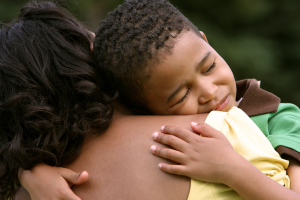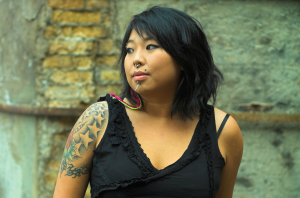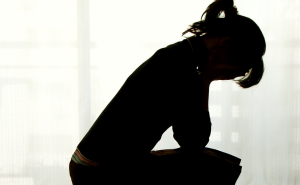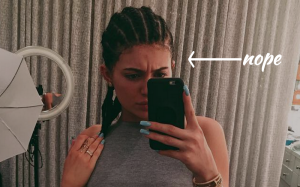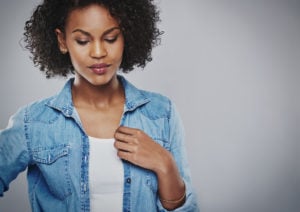
A young person sits at a desk in front of open books, writing something in a notebook.
“I will always be dangerous—”
“In their eyes.”
“I will always be loud—”
“That’s just the way I speak.”
“I will always be wise—”
“I’m just stating my point.”
“I will always feel violated—”
“As long as we have scanning.”
“I will always be unladylike—”
“What is ladylike?”
In 2015, youth organizers from Girls for Gender Equity performed this piece at the American Education Research Association’s conference. Combining their shared experiences in schools, these young Black women talked about how they feel frustrated with the school system.
The entire piece talks about how just trying to make it through a school morning can be extremely difficult for them as young women of color. Having to go through metal detectors, dealing with unsympathetic adults, and getting kicked out of class for expressing emotions are all part of a daily reality for these young women.
From the moment they get onto school property, they’re being punished.
Although this piece came from very specific experiences, this is a very common narrative for young people of color in schools. Black, Native, and Latinx students are overwhelmingly impacted by punitive policies, especially if they are disabled and/or LGBTQIA+.
Policymakers, administrators, and teachers often implement school policies that claim to create a “more secure” and “respectful” environment.
After the Columbine shooting, there was an increase in security measures in schools nationwide to ensure that young people could be safe in schools.
As Nancy Heitzeg explains in The School-to-Prison Pipeline, this negatively affects students of color. White students in suburban areas received an increase in guidance counselors and mediation programs.
For Black and Brown students in mostly urban areas, this meant creating zero-tolerance policies and increasing police presences, which directly fuels the school-to-prison pipeline.
This is all because of implicit bias against people of color. Rather than treating students of color as growing people who come from different environments and experiences, our young people are criminalized and expected to conform to strict Eurocentric standards. Intentional discrimination against students of color is also present in disciplinary actions.
And when young people of color fail – exactly as they are set up to do – a system of school push-out is created.
The Dignity in Schools Campaign explains that school push-out is what happens when “numerous factors that prevent or discourage young people from remaining on track to complete their education.”
I want to note that it’s important to name this specifically as “school push-out,” rather than students “dropping out.”
When folks say “a student dropped out,” the burden is placed on the one student for not completing their education. We need to refocus our attentions on what institutional barriers were put in place so that overwhelmingly, many students could not continue going to school.
While this affects all students of color, many reforms and funding have only focused on how school push-out has directly affected Black boys and other young men of color. Initiatives like My Brother’s Keeper and Campaign for Black Male Achievement aim to reform school systems and keep young men of color in schools.
But as Kimberle Crenshaw has explained, only funding Black boys and other boys of color doesn’t fix anything systemically. The ACLU has also talked about how unfair it is to focus only on boys of color, when girls of color are also facing intense discrimination.
It is also the case that young women and gender non-conforming youth of color are discriminated against in ways that young men of color are not. The National Women’s Law Center and Girls for Gender Equity 2015 report explains how nationally schools disproportionately target young women of color in racialized and gendered ways.
An advocate in report explains, “Much of this discipline flows from the perception that [girls of color’s] femininity is flawed. Discipline is used as a means to have Black girls conform to stereotypical forms of femininity.”
Because of misogynoir, young Black women are stereotyped and punished for being themselves. As the NAACP report, Unlocking Opportunity for African American Girls, explains, Black girls are coded as “loud, confrontational, assertive, and provocative” in schools.
Because this is in direct opposition to traditional, Eurocentric expectations of femininity, Black girls are then punished, almost as soon as they go through school doors.
Below are just a few school policies and punitive rules that disproportionately target young Black women.
1. Strict Dress Codes
Earlier this year, a Black girl in third grade was removed from class for violating a dress code policy. The assistant principal told her that her natural hair was “inappropriate,” and she was sent home.
A major feminist issue in schools is how sexist school dress code policies often are. There are many sources, many from young women themselves, explaining that girls and LGBTQIA+ youth are disproportionately targeted by dress codes.
Young women are often told that they are dressed “too provocatively,” and are “distracting” boys and even male teachers. Young women are often shamed for their bodies or sent home, meaning that they lose valuable education time.
Strict dress codes especially target Black girls and Latinas in multiple ways.
Because young women of color are deemed as “too fast,” and their bodies are hypersexualized, Black girls are seen as inherently provocative. Outfits that are appropriate on white girls are “slutty” on women of color.
In “Ogbu Revisited: Unpacking High-Achieving African American Girls’ High School Experiences,” a young Black girl explains, “[T]hey have different rules for us… White girls and Asian girls can wear anything and get away with it, but they will send us to the dean for wearing the same thing.”
In “‘Ladies’ or ‘Loudies’?” Edward Morris explains that this is part of further policing Black girls through a Eurocentric lens of what young women should wear.
Administrators both tried to “dissuade Black girls at the school from wearing overly provocative ‘hoochie mama’ clothing, seen as a mark of inappropriate, overly sexual femininity” and restricted girls from wearing “oversized or baggy clothing.” Black girls that strayed too far from the gender norms of white femininity were punished.
Furthermore, clothing that is banned for “gang affiliations” are often just clothes that Black and Latinx students wear. Students of color who use clothing to express their political activism or religious and cultural pride are punished.
But these go beyond clothing.
As mentioned above, Black girls are often policed for their hair. For Black girls, natural hair and head wraps are often found in violation of dress codes. Black girls are told that their hair is “too distracting,” “messy,” or “unhygienic.” This comes from a long history of Black women being policed and disciplined for wearing their hair naturally.
2. Attitude Policing
Miasia had once been suspended for “talking back,” when she approached her school dean about feeling disrespected by teachers. Kaya has been told that her demeanor is inappropriate; a teacher stopped her to tell her that she “walks around like she’s better than everyone.”
These stories come from a few youth organizers with Girls for Gender Equity. They have explained how administrators have belittled or suspended them for how the dress, speak, and defend themselves. From the same video, Imade seems to explain it best: It’s often the case that teachers assume that Black girls are going to be too loud and be problems in the classroom, and then punish them harshly for it.
Across the country, educators have had full range to suspend or discipline a student if they didn’t like their attitude. In New York City, it is called “defying authority.” In California, it is called “disruption or willful defiance.”
Because of how vague these guidelines are, some educators have used these policies as methods of punishing students for minor infractions.
Students can be suspended for not being “ladylike” or for having an “attitude.” In many cases, suspension or punishment because of a student’s attitude has been directly related to that student’s ethnic or racial background.
Girls of color, especially Black girls, have been disproportionately punished because of having an “attitude problem.” Educators come in assuming their students are going to be the “loud, ghetto Black girl” stereotype and punish them just for existing in the classroom.
Student activists have spoken about how policies like this, rooted in implicit biases, disproportionately target Black and Latinx students. The YWCA has explained that Black girls especially are perceived to be “defiant, loud, and unmanageable,” leading to harsher disciplinary actions against them.
In her book, Pushout: The Criminalization of Black Girls in Schools, Monique Morris goes into this phenomenon in detail. She explains that Black girls are more likely to be punished for being “disrespectful” or “undisciplined deviants” because of stereotypes that educators bring into the classroom.
3. Lax Sexual Assault Policies
Earlier this year, G., a thirteen-year-old Black girl, was raped in school by another student. Her rapist also secretly filmed this assault, and sent it to other students. When she reported the rape, she was blamed for her own assault, suspended indefinitely, and forced to transfer schools.
By refusing to offer counseling or legal aid, blaming this young woman for her own assault, and blatantly disregarding Title IX, this middle school completely failed this young girl. And unfortunately, this scenario has been all too common for young people in public middle and high schools in New York and across the country.
According to the Rape, Abuse, & Incest National Network (RAINN), of victims under eighteen, 34% of sexual assault victims are under the age of twelve; 66% of sexual assault victims are between the ages of twelve and seventeen.
Many of these incidents take place in school. For just one small example, a 2014 study done in the Midwest shows that one in four middle school students have experienced verbal or physical sexual harassment in school.
Monique Morris explains that these rates are even higher for young Black girls, who are often seen as much older and are hypersexualized by peers and school administrators. This is only heightened for trans Black girls. 48% of Black trans and gender non-conforming students reported sexual harassment, assault, and expulsion in school.
Although many regulations are in place to protect victims of sexual assault and harassment, many schools have not been doing their job.
A large problem is also the fact that many schools don’t have comprehensive sexual education classes, and many students are not taught about consent. Students are not taught their Title IX rights, and neither are administrators. Educators often end up punishing the victim, rather than protecting them.
When schools consistently blame victims and have lax policies, school becomes an unsafe environment. Young Black girls are pushed out of schools. This happens when they are too scared to continue attending, or literally forced out by school administration.
4. Overuse of Suspensions and Expulsions
The African American Policy Forum’s 2015 report, Black Girls Matter: Pushed Out, Overpoliced, and Underprotected shows that Black girls are overwhelmingly suspended and expelled from school.
The data shows that Black girls are usually punished for “subjective behavioral infractions.” Again, because Black girls are stereotyped and do not fit in “traditional” roles of femininity, they are excessively punished.
A Villanova University report also found that due to colorism, dark-skinned Black girls were even more likely to be suspended than other girls. Dr. Lance Hannon explains, “[W]hen a darker-skinned African-American female acts up, there’s a certain concern about their boyish aggressiveness” – “that they don’t know their place as a female, as a woman.”
The overuse of suspensions and policing of Black girls follows them throughout their entire academic career.
In a survey including almost 1.5 million preschools, the US Department of Education found that even though Black girls “represent 20% of preschool enrollment, 54% of preschool girls suspended once or more” were Black.
Yup, you read that right. Even in preschool, Black girls are more likely to be suspended than white girls.
Another study, done by the University of Pennsylvania, tracked the suspension rates of K-12 students in thirteen Southern states. The study found that Black girls comprised of 56% of suspensions and 45% of expulsions, and were the most suspended group across ten states amongst girls.
These suspensions, done in the name of “teaching a lesson,” often only work to push Black girls away from schools.
The Dignity in Schools Campaign has explained that suspensions often do more harm than good. Suspensions force students to miss class and often are used to punish a student without understanding why they might have done something. For Black girls especially, it’s used as a tool to criminalize them.
A study by the National Survey for Children’s Health explains that what students of color really need are more supports, not suspensions. Many “behavioral issues” that Black students and other students of color have are because of trauma or lack of support.
Rather than helping young people, educators are further punishing them. It’s restorative and healing practices, not punitive policies, that can really help students and change behavior.
5. Police Presences
In Maryland last year, a Black girl in middle school had to receive ten stitches after a school police officer beat her with a baton. Her cousins, trying to defend her, were both sprayed in the face with pepper spray. All the girls were suspended and sent to an alternative school.
As I’ve talked about before, police do not belong in schools.
Yet, according to the US Department of Education, more than half of high schools with high Black and Latinx enrollment have sworn law enforcement officers.
Furthermore, Black students are 1.2 times as likely than white students to attend a school with law enforcement officers, but no guidance counselors.
Rather than create secure environments, police further criminalize young people of color. Police in schools not only seek to intimidate young people, but increase the likelihood of arrests and students being “referred to law enforcement, even for minor behavior.” This leads to a violent cycle, where Black girls and other girls of color are pushed into the juvenile justice system.
At INCITE’s Color of Violence 4 conference in 2015, Connie Wun spoke about her work with young Black girls. She explained that schools were not only conduits for the school-to-prison pipeline, but were “carceral institutions” themselves for Black girls and other young women of color. These young people are treated as if they are inherently criminal.
Police and school safety agents have physically arrested and actively harmed Black girls. Furthermore, the school building itself has become a site of punishment. Young people are immediately criminalized as soon as they enter these buildings. Between metal detectors, bag searches, and pat-downs, schools tell students, “We don’t trust you.”
As one student activist with Dignity in Schools has said, “School is an environment where people come to learn. Instead of learning, it feels like a prison.”
***
Schools are supposed to be places of growing and learning. Unfortunately for Black girls, they are often sites of violence and punishment.
Policymakers, administrators, and teachers need to confront the ways that many of the rules made to keep students “safe” are really just used to police and criminalize Black girls.
But more than that, there needs to be an entire school climate shift.
Across the country, Black girls and other students are explaining what they need from educators and how they envision better schools. Too often, education policy relies on talking about young people, and not learning from them.
Young people deserve to be in schools that are not only non-oppressive, but that are enjoyable experiences. Most of a young person’s time in spent in schools. Schools need to have loving adults, teach diverse and representative curriculum, and become spaces where young people feel good about who they are.
[do_widget id=’text-101′]
Jennifer Loubriel is a Contributing Writer for Everyday Feminism and a mixed race Afro-Puerto Rican from the Bronx. She is also a queer mujerista and child abuse survivor. She earned her B.A. from Oberlin College in Religion and English, and identifies as an amateur Latinx ethicist and a speculative fiction enthusiast. She is a co-founder and moderator over at the Tumblr Women of Color, in Solidarity, a safe space for and by women of color.
Search our 3000+ articles!
Read our articles about:
Our online racial justice training
Used by hundreds of universities, non-profits, and businesses.
Click to learn more
Most Read Articles
- « Previous
- 1
- …
- 30
- 31
- 32









